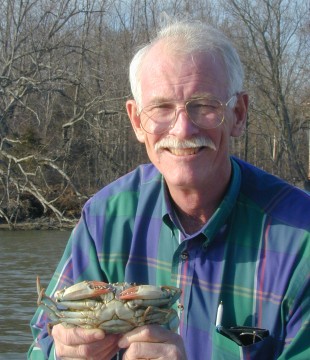Anson “Tuck” Hines
Director, Smithsonian Environmental Research Center
Anson “Tuck” Hines has served as director of the Smithsonian Environmental Research Center (SERC) since 2005. Located on the Chesapeake Bay 25 miles east of Washington, D.C., SERC studies human impacts, natural processes and land-sea connections in coastal ecosystems.
Hines served as SERC’s assistant director from 1988 to 2004 and has been a marine ecologist and principal investigator of SERC’s Fish & Invertebrate Ecology Laboratory since 1979. As director, he oversees research, professional training and public programs in climate change, landscape ecology, pollution in coastal ecosystems, invasive species, fishery impacts and loss of biodiversity. SERC programs extend around the world with global research networks in forest and marine ecosystems.
Hines has a Bachelor of Arts degree in zoology from Pomona College and a doctorate in zoology from the University of California, Berkeley. He has conducted research on coastal ecosystems in Chesapeake Bay, Florida, California, Alaska, Belize, Japan and New Zealand. Hines has been leader on a diverse array of 140 research projects funded by extramural grants and contracts, including effects of thermal discharges of coastal power plants, sea otters and kelp forest ecology, long-term ecological change in Chesapeake Bay, marine food web dynamics, predator–prey interactions, impacts of fisheries, aquaculture and fishery restoration, crustacean life histories and biological invasions of coastal ecosystems. An expert on blue crabs, he has studied the biology of crabs around the world. Hines has published more than 160 articles in technical journals and books.
Hines has advanced SERC’s land conservation program, which now encompasses 2,654 acres of the Rhode River watershed and 15 miles of shoreline, providing the largest contiguous block of land for environmental research, public education and access on the shoreline of Chesapeake Bay. He also led an innovative facilities master plan for sustainable development and management of the Rhode River site. In 2014, he oversaw construction of the $57 million Mathias Laboratory, the first LEED-Platinum building in the Smithsonian. In 2023, he supervised the addition of six LEED-Platinum and PHIUS certified net-positive energy Visitor Cottages for visiting scientists and other guests to the SERC campus. He promoted the establishment of the Smithsonian Marine Science Network for comparative studies of coastal ecosystems at the Institution’s four long-term research facilities along the Western Atlantic. Hines is an adjunct professor at the University of Maryland, College Park. He also has served as a major advisor for 20 postdoctoral fellows, 11 doctoral students and 10 Master of Science students, and as mentor for more than 165 undergraduate interns.
# # #
SI-81-2024

